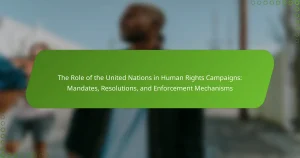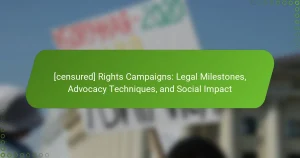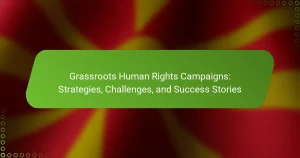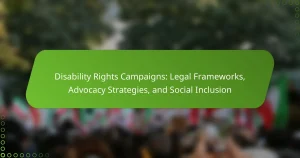Refugee rights campaigns are initiatives designed to advocate for the legal protections and rights of refugees, addressing critical issues such as asylum processes, healthcare access, and education. These campaigns involve various organizations, including non-governmental organizations (NGOs) and international bodies, which work to raise public awareness and lobby for improved policies. Legal frameworks like the 1951 Refugee Convention and its 1967 Protocol establish fundamental rights for refugees, while advocacy efforts aim to combat discrimination and promote integration. Global responses to refugee crises include humanitarian aid, resettlement programs, and international cooperation, with millions of displaced individuals requiring protection and assistance. This article explores the intersection of legal protections, advocacy efforts, and global responses in the context of refugee rights campaigns.
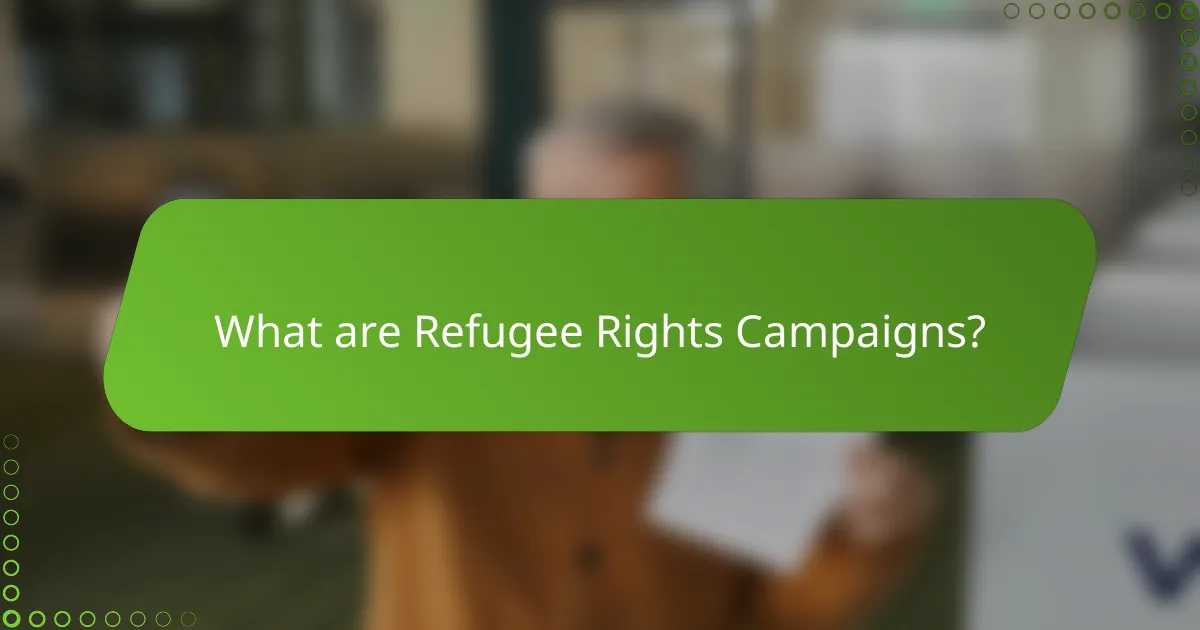
What are Refugee Rights Campaigns?
Refugee rights campaigns are initiatives aimed at advocating for the legal protections and rights of refugees. These campaigns seek to raise awareness about the challenges refugees face. They often focus on issues such as asylum processes, access to healthcare, and education. Organizations involved in these campaigns include NGOs, human rights groups, and international bodies. Campaigns may involve lobbying governments to improve policies. They also aim to mobilize public support for refugee issues. Statistics show that millions of people are displaced globally, highlighting the need for such advocacy. Effective campaigns can lead to significant changes in legislation and public perception.
How do Refugee Rights Campaigns operate globally?
Refugee rights campaigns operate globally through advocacy, legal support, and awareness-raising initiatives. These campaigns aim to protect the rights of refugees and promote their integration into host societies. Organizations like the United Nations High Commissioner for Refugees (UNHCR) lead efforts to ensure compliance with international treaties. They collaborate with local NGOs to provide legal assistance and resources. Campaigns often utilize social media to reach a wider audience and mobilize support. For example, the Global Refugee Forum highlights commitments from various countries to improve refugee conditions. Research indicates that advocacy significantly influences policy changes in host nations. Ultimately, these campaigns strive to create a more humane and just response to the global refugee crisis.
What are the key objectives of Refugee Rights Campaigns?
The key objectives of Refugee Rights Campaigns include advocating for legal protections for refugees. These campaigns aim to ensure that refugees have access to asylum processes. They seek to raise awareness about the rights and needs of displaced individuals. Campaigns also focus on combating discrimination and xenophobia against refugees. Another objective is to influence policy changes at local, national, and international levels. They strive to mobilize public support and engagement for refugee issues. Additionally, campaigns aim to provide resources and support for refugees’ integration into host communities. These objectives are essential for promoting the dignity and rights of refugees globally.
Who are the main stakeholders involved in these campaigns?
The main stakeholders involved in refugee rights campaigns include non-governmental organizations (NGOs), government agencies, and international bodies. NGOs such as the UNHCR advocate for refugee protections and rights. Government agencies implement policies and provide funding for refugee programs. International bodies like the United Nations coordinate global responses and set legal frameworks. Each stakeholder plays a crucial role in shaping the landscape of refugee rights. Their collaboration is essential for effective advocacy and legal protections.
Why are Refugee Rights Campaigns important?
Refugee rights campaigns are important because they advocate for the protection and dignity of displaced individuals. These campaigns raise awareness about the challenges refugees face, including violence, discrimination, and lack of basic needs. They aim to influence policy changes that ensure legal protections for refugees. According to the United Nations High Commissioner for Refugees (UNHCR), there are over 26 million refugees globally as of 2021. Advocacy efforts help mobilize resources and support from governments and organizations. Effective campaigns can lead to increased funding for refugee assistance programs. They also foster community support and integration initiatives. Ultimately, these campaigns are essential for upholding human rights and promoting social justice.
What impact do these campaigns have on refugee populations?
Refugee rights campaigns significantly improve the conditions and protections for refugee populations. These campaigns raise awareness about the challenges refugees face. They advocate for legal protections that ensure safety and access to resources. Increased public support often leads to policy changes that benefit refugees. For example, campaigns can influence governments to adopt more inclusive asylum policies. Additionally, they provide platforms for refugees to share their stories. This visibility can foster empathy and support from host communities. Ultimately, these campaigns contribute to a more favorable environment for refugees to rebuild their lives.
How do Refugee Rights Campaigns influence public policy?
Refugee rights campaigns significantly influence public policy by raising awareness and advocating for legislative changes. These campaigns mobilize public opinion, which pressures policymakers to address refugee issues. For example, the Refugee Council in the UK successfully lobbied for the protection of asylum seekers’ rights in the 2016 Immigration Act. Additionally, campaigns often provide evidence-based research that informs policymakers about the needs of refugees. This data can lead to the development of more humane immigration policies. Advocacy efforts also promote international agreements, such as the Global Compact on Refugees, which encourages nations to share responsibility for refugee protection. Through grassroots mobilization, these campaigns empower communities to demand accountability from their governments. Overall, refugee rights campaigns play a critical role in shaping policies that affect millions of displaced individuals worldwide.
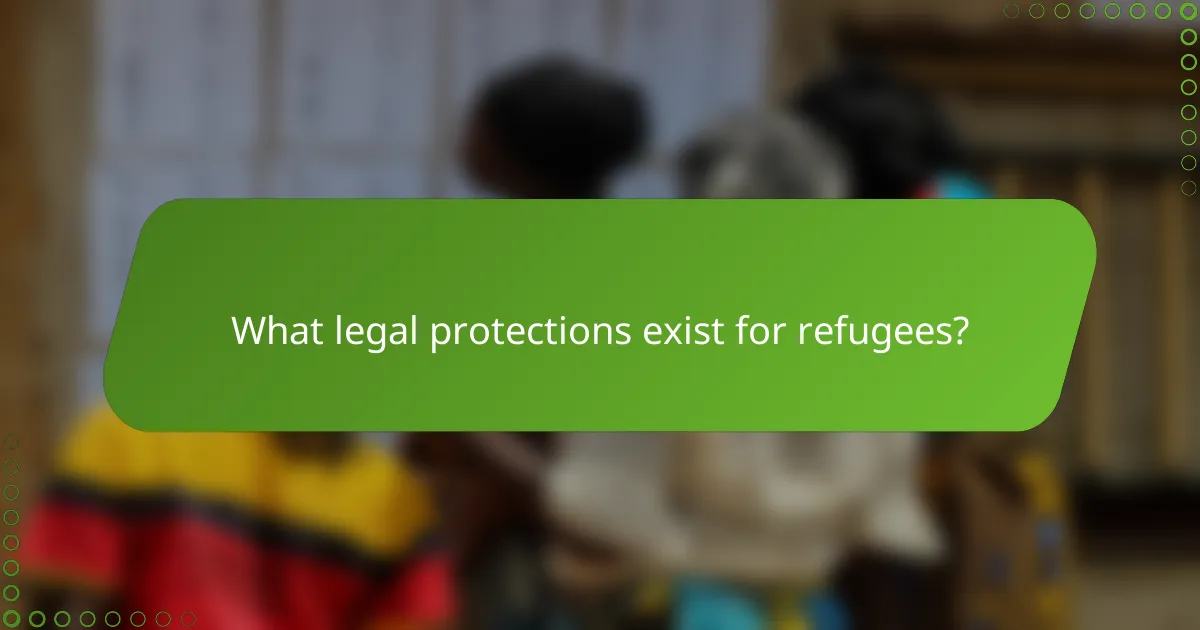
What legal protections exist for refugees?
Refugees are legally protected under various international and national laws. The 1951 Refugee Convention and its 1967 Protocol establish fundamental rights for refugees. These include the right to seek asylum and protection from refoulement, which is the forced return to a country where they face threats. Additionally, international human rights laws, such as the International Covenant on Civil and Political Rights, safeguard their rights. Many countries have domestic laws that align with these international standards, providing further protections. For instance, the U.S. Refugee Act of 1980 integrates the Refugee Convention into U.S. law, ensuring legal status and benefits for refugees.
How do international laws protect refugee rights?
International laws protect refugee rights through various treaties and conventions. The 1951 Refugee Convention outlines the definition of a refugee and establishes their rights. It mandates that refugees should not be returned to countries where they face serious threats to their life or freedom, known as the principle of non-refoulement. Additionally, international human rights laws ensure that refugees have access to basic rights, such as the right to seek asylum, work, and education. Countries that ratify these treaties are legally obligated to uphold these protections. The United Nations High Commissioner for Refugees (UNHCR) monitors compliance and provides guidance on refugee protection.
What are the key international treaties related to refugee rights?
The key international treaties related to refugee rights include the 1951 Refugee Convention and its 1967 Protocol. The 1951 Refugee Convention defines a refugee and outlines the rights of individuals who are granted asylum. It establishes the principle of non-refoulement, which prohibits returning refugees to places where they face serious threats to their life or freedom. The 1967 Protocol expands the scope of the Convention by removing geographical and temporal restrictions. Another important treaty is the 1984 Convention Against Torture, which prohibits torture and inhumane treatment of refugees. Additionally, the 1990 International Convention on the Protection of the Rights of All Migrant Workers and Members of Their Families also addresses the rights of migrant workers, including refugees. These treaties collectively form a legal framework aimed at protecting the rights of refugees globally.
How do these treaties affect national legislation?
Treaties affect national legislation by establishing legal obligations for countries to protect refugees. These international agreements require signatory states to align their laws with treaty provisions. For example, the 1951 Refugee Convention mandates that countries must not return refugees to places where their lives are at risk. Compliance with such treaties often leads to the enactment or amendment of national laws. Countries may create legal frameworks that ensure refugee rights are upheld. Additionally, treaties can influence domestic policies by promoting best practices in refugee protection. This alignment helps to standardize responses to refugee crises globally.
What role do national laws play in refugee protections?
National laws provide the framework for the protection of refugees within a country. These laws establish the rights and responsibilities of refugees and the obligations of the state. National legislation often aligns with international treaties, such as the 1951 Refugee Convention. Countries may create specific laws that define who qualifies as a refugee. They also outline procedures for asylum applications and appeals. Enforcement of these laws can vary significantly between nations. Some countries offer robust protections, while others may have restrictive policies. The effectiveness of national laws directly impacts the safety and well-being of refugees.
How do different countries implement refugee rights?
Different countries implement refugee rights through a combination of national laws, international treaties, and humanitarian policies. For instance, countries like Germany and Canada have established comprehensive legal frameworks to protect refugee rights. Germany adheres to the 1951 Refugee Convention and its 1967 Protocol, providing asylum seekers with access to legal aid and social services. Canada has a robust refugee determination process that includes hearings and appeals, ensuring fair treatment.
In contrast, some nations may have limited protections or face challenges in enforcement. For example, countries experiencing conflict may struggle to uphold refugee rights due to instability. The United Nations High Commissioner for Refugees (UNHCR) monitors compliance with international standards, advocating for improvements where necessary.
Overall, the implementation of refugee rights varies significantly across countries, influenced by legal, political, and social factors.
What challenges do countries face in enforcing these laws?
Countries face multiple challenges in enforcing refugee rights laws. Limited resources hinder effective implementation of these laws. Many countries lack adequate funding and staff to manage refugee cases. Political instability can disrupt legal processes and enforcement. Public opinion may influence government actions against refugees, leading to non-compliance. Additionally, legal frameworks may vary significantly between countries, creating inconsistencies. Some nations may prioritize national security over humanitarian obligations, affecting enforcement. Lastly, international cooperation is often insufficient, complicating cross-border refugee protection efforts.
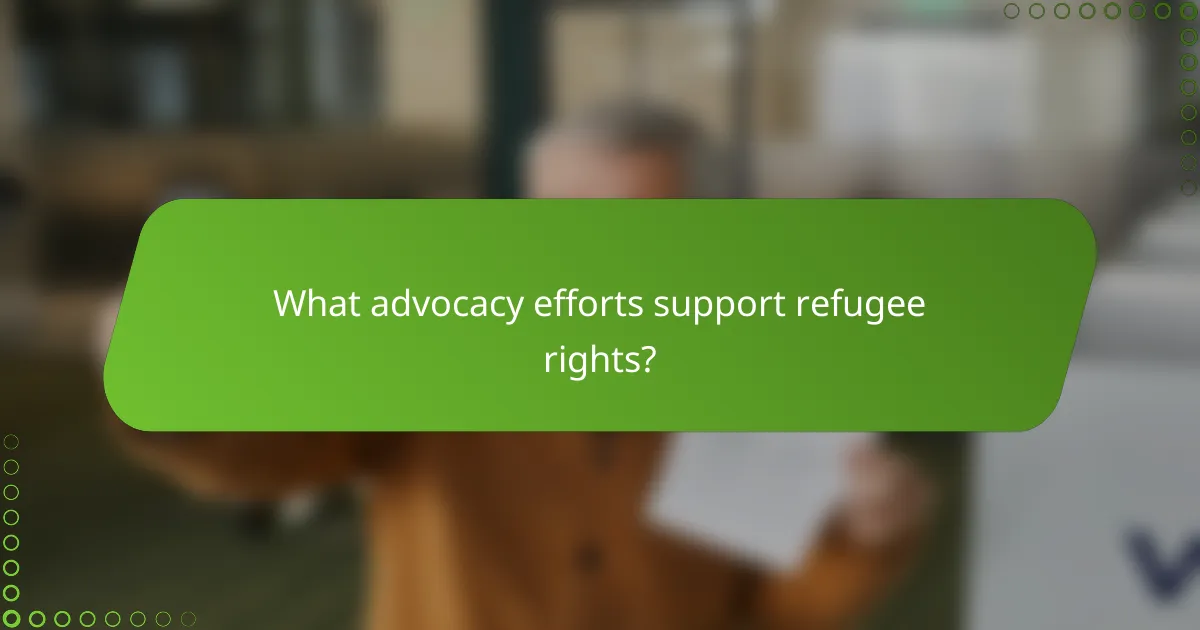
What advocacy efforts support refugee rights?
Advocacy efforts supporting refugee rights include legal frameworks, grassroots movements, and international organizations. Legal frameworks such as the 1951 Refugee Convention establish protections for refugees. Grassroots movements raise awareness and mobilize communities to support refugees. Organizations like the UNHCR advocate for policy changes and provide essential services. Campaigns often focus on ending discrimination and promoting integration. Data shows that public support for refugees increases with awareness campaigns. Research indicates that strong advocacy leads to improved policies and protections for refugees.
How do non-governmental organizations (NGOs) contribute to advocacy?
Non-governmental organizations (NGOs) contribute to advocacy by raising awareness about refugee rights. They mobilize communities and influence policymakers. NGOs conduct research to highlight issues faced by refugees. They provide legal assistance and support to affected individuals. NGOs often collaborate with other organizations to amplify their impact. They engage in public campaigns to educate the broader public. According to the UNHCR, NGOs play a crucial role in protecting refugees’ rights globally. Their efforts lead to policy changes and increased funding for refugee assistance programs.
What are some prominent NGOs focused on refugee rights?
Some prominent NGOs focused on refugee rights include the United Nations High Commissioner for Refugees (UNHCR), Refugees International, and the International Rescue Committee (IRC). UNHCR leads global efforts to protect and support refugees. It operates in over 130 countries, providing essential services and advocating for refugee rights. Refugees International focuses on policy advocacy and mobilizing resources for refugee protection. It conducts field missions to assess refugee needs and influence policymakers. The IRC offers humanitarian aid and support services to refugees and displaced persons. It addresses health, education, and economic needs in crisis-affected areas. These organizations play crucial roles in promoting and safeguarding the rights of refugees worldwide.
How do these organizations mobilize public support?
Organizations mobilize public support by raising awareness of refugee issues. They utilize social media campaigns to reach a broader audience. They often organize events and rallies to engage community members. Partnerships with local influencers help amplify their messages. Educational programs are implemented to inform the public about refugee rights. They also share personal stories of refugees to evoke empathy. Statistics and reports are used to highlight the urgency of the situation. These strategies aim to create a sense of urgency and encourage action from the public.
What strategies are effective in raising awareness for refugee rights?
Effective strategies for raising awareness for refugee rights include community engagement, social media campaigns, and educational programs. Community engagement fosters direct interaction and personal stories, which humanize the refugee experience. Social media campaigns leverage platforms like Twitter and Facebook to reach a broader audience quickly. Educational programs in schools and communities inform people about refugee rights and challenges. Collaborations with local organizations amplify efforts and resources. Advocacy through events and workshops encourages public participation. Research shows that grassroots movements can significantly influence public opinion and policy changes.
How can social media campaigns influence public perception?
Social media campaigns can significantly influence public perception by shaping narratives and disseminating information rapidly. These campaigns utilize platforms like Twitter, Facebook, and Instagram to reach wide audiences. They often highlight personal stories and testimonials, making complex issues relatable. Research shows that emotional content is more likely to be shared, amplifying the message. For instance, a study by the Pew Research Center found that 69% of adults in the U.S. use social media, creating a vast network for information spread. Additionally, social media allows for real-time engagement, enabling immediate responses to public concerns. This interactive aspect fosters community and solidarity around causes, enhancing visibility and support for refugee rights.
What role do community events play in advocacy efforts?
Community events serve as crucial platforms for advocacy efforts. They foster awareness about refugee rights and related issues. These gatherings facilitate direct engagement between advocates and community members. They provide opportunities for sharing personal stories and experiences. This personal connection can inspire empathy and action. Community events often mobilize support and resources for advocacy campaigns. They also help to build coalitions among various stakeholders. Research shows that grassroots movements gain momentum through such events, amplifying their impact.
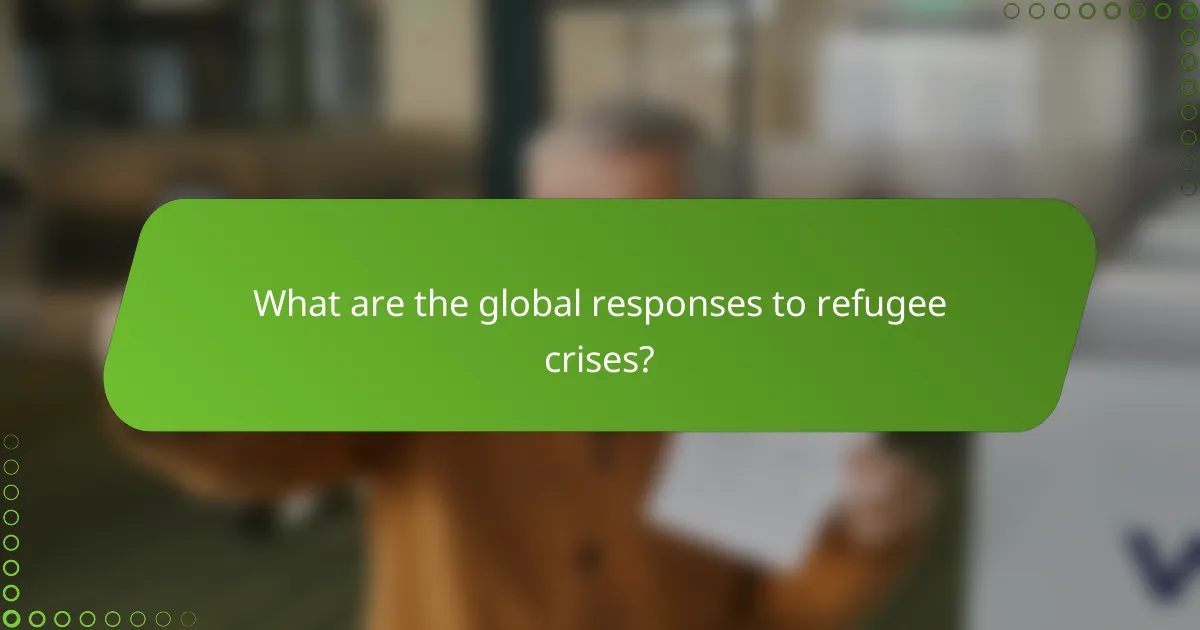
What are the global responses to refugee crises?
Global responses to refugee crises include humanitarian aid, resettlement programs, and international cooperation. Countries often provide emergency assistance, such as food, shelter, and medical care. The United Nations High Commissioner for Refugees (UNHCR) coordinates these efforts globally. Resettlement programs allow refugees to start anew in third countries. For example, the U.S. and Canada have established significant resettlement initiatives. Countries also participate in international agreements like the Global Compact on Refugees. These agreements aim to enhance cooperation and support for host nations. Additionally, advocacy efforts by NGOs raise awareness and promote refugee rights. Data shows that over 26 million refugees worldwide require protection and assistance.
How do different countries respond to refugee influxes?
Countries respond to refugee influxes in various ways. Some nations implement open-door policies, allowing refugees to enter freely. For example, Germany accepted over one million refugees during the Syrian crisis in 2015. Other countries may impose strict border controls and limit the number of refugees. Hungary, for instance, built a border fence to prevent entry during the same period.
Additionally, countries often provide temporary shelter and basic services to refugees. In Lebanon, refugees make up about 25% of the population, leading to significant strains on resources. Some nations collaborate with international organizations for support. The UNHCR assists countries like Turkey, which hosts the largest number of refugees globally, exceeding 3.6 million.
Responses can also include resettlement programs. The United States has historically resettled large numbers of refugees, with over 3 million since 1975. However, policies can change based on political climates, affecting the number of accepted refugees.
What are the varying approaches to refugee resettlement?
Varying approaches to refugee resettlement include government-led programs, community-based initiatives, and private sponsorship schemes. Government-led programs typically involve national policies that allocate resources for resettling refugees. Countries like Canada and Australia have established structured frameworks for refugee intake and integration. Community-based initiatives focus on local organizations supporting refugees through housing, employment, and social services. These programs often rely on volunteer efforts and local funding. Private sponsorship schemes allow individuals or groups to financially support refugees, ensuring their successful resettlement. Research indicates that countries employing diverse resettlement approaches demonstrate increased refugee integration and community support.
How do countries collaborate in addressing refugee issues?
Countries collaborate in addressing refugee issues through international agreements and frameworks. They participate in treaties like the 1951 Refugee Convention. This convention sets out the rights of refugees and the legal obligations of states. Countries also engage in joint initiatives to share resources and best practices. For instance, the Global Compact on Refugees aims to improve international cooperation. Additionally, nations often work with organizations like the UNHCR for coordinated responses. Data shows that collaborative efforts can lead to better support for refugees. In 2021, over 80 million people were forcibly displaced worldwide, highlighting the need for effective collaboration.
What challenges do global responses face?
Global responses to refugee rights face significant challenges. Political instability in host countries often hinders effective implementation of policies. Economic constraints limit resources available for refugee support and integration. Legal frameworks can be inconsistent, leading to gaps in protection. Public opinion may be polarized, affecting advocacy efforts. Coordination among international organizations can be complicated by differing priorities. Additionally, cultural differences can create barriers to integration. These challenges collectively impede the effectiveness of global responses to refugee rights.
How do political climates affect refugee support initiatives?
Political climates significantly influence refugee support initiatives. In supportive political environments, governments and organizations often allocate more resources to aid refugees. For example, countries with progressive policies may implement comprehensive integration programs. Conversely, hostile political climates can lead to reduced funding and increased barriers for refugees. Countries experiencing anti-immigrant sentiments often see a decline in public support for refugee initiatives. Historical data shows that during the Syrian refugee crisis, nations with welcoming policies, like Canada, successfully resettled more individuals compared to those with restrictive policies, such as Hungary. Therefore, the political landscape directly shapes the effectiveness and scope of refugee support initiatives.
What are the implications of funding shortages for refugee programs?
Funding shortages for refugee programs lead to significant operational challenges. These challenges include reduced access to essential services such as healthcare, education, and housing. A lack of financial resources can cause delays in processing asylum claims. It may also result in inadequate support for resettlement and integration efforts. According to the United Nations High Commissioner for Refugees (UNHCR), funding shortfalls have led to a decrease in food aid for refugees in various regions. This situation can exacerbate health issues and increase vulnerability among refugee populations. Furthermore, funding shortages hinder the ability to respond effectively to emergencies and crises. Ultimately, these implications can lead to increased instability and suffering for refugees.
What can individuals do to support refugee rights?
Individuals can support refugee rights by advocating for policy changes and raising awareness. They can contact local representatives to express support for refugee-friendly legislation. Volunteering with organizations that assist refugees provides direct help. Donations to refugee support groups can help fund essential services. Educating oneself and others about refugee issues fosters understanding and empathy. Attending events or rallies shows solidarity with refugees. Signing petitions can amplify calls for change. Supporting businesses that hire refugees promotes economic integration.
How can community members get involved in local advocacy?
Community members can get involved in local advocacy by participating in organized events and campaigns. They can join local organizations that focus on refugee rights. Volunteering time and skills to these organizations is also beneficial. Attending community meetings helps raise awareness about refugee issues. Engaging in discussions with local policymakers can influence decisions. Sharing information on social media amplifies advocacy efforts. Contributing to fundraising initiatives supports local advocacy programs. Collaborating with other community members strengthens collective action.
What resources are available for educating others about refugee rights?
Educational resources for refugee rights include online platforms, publications, and community programs. Organizations like the United Nations High Commissioner for Refugees (UNHCR) provide comprehensive guides and toolkits. The Refugee Council offers resources aimed at raising awareness and understanding. Academic institutions often publish research papers on refugee issues. Websites like Refugee Rights Europe provide educational materials and reports. Local NGOs frequently conduct workshops and seminars to inform the public. These resources are crucial for fostering awareness and advocacy in support of refugee rights.
Refugee rights campaigns are initiatives dedicated to advocating for the legal protections and rights of refugees, addressing challenges such as asylum processes, healthcare access, and education. This article explores the operation of these campaigns globally, their key objectives, and the main stakeholders involved, including NGOs and international bodies. It highlights the importance of advocacy efforts in shaping public policy and improving conditions for refugees, alongside the legal frameworks established by international treaties. Additionally, the article examines the varying responses of countries to refugee crises and the challenges faced in enforcing refugee rights, while providing insights into how individuals and communities can support these efforts.

